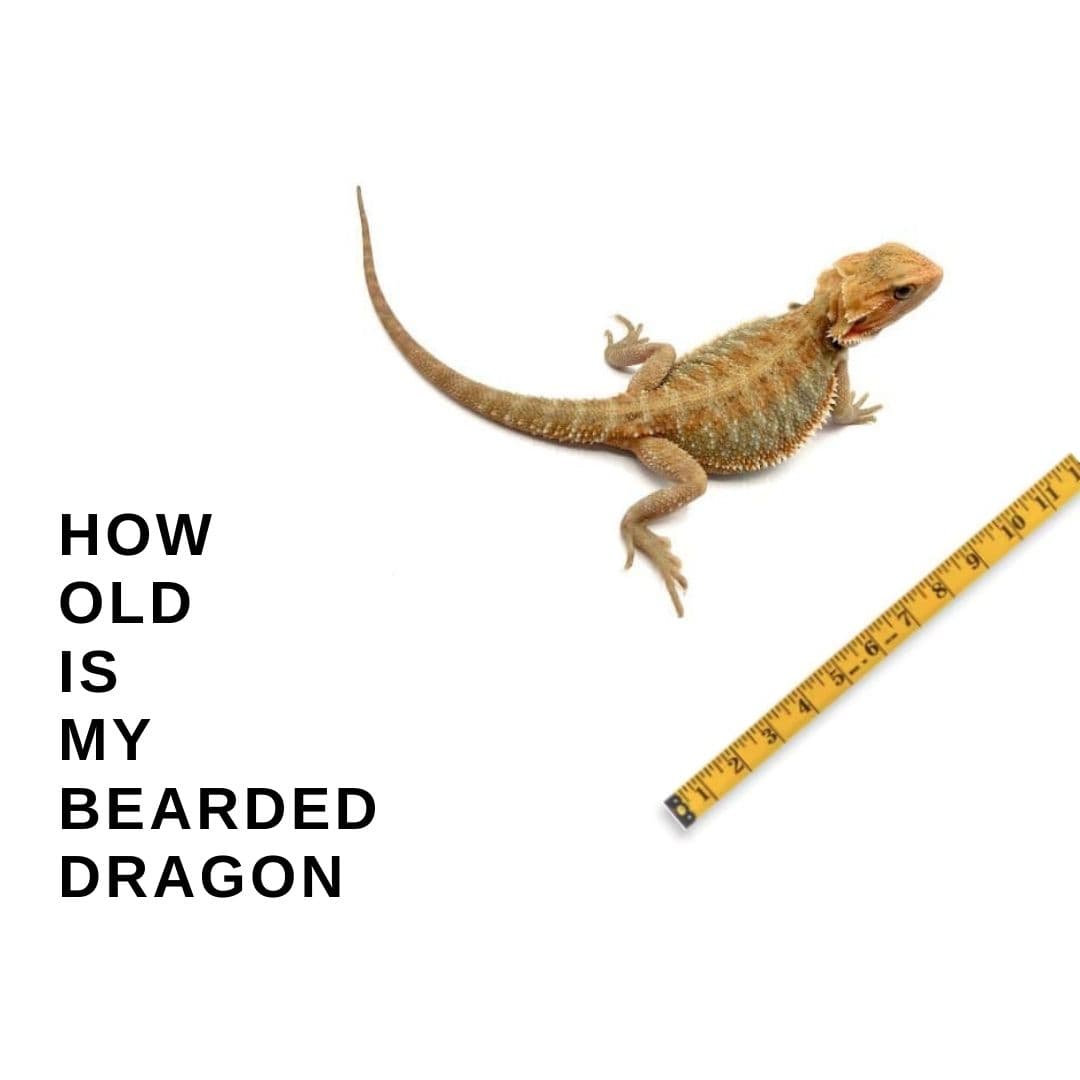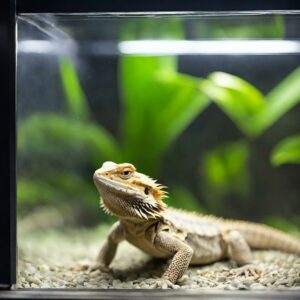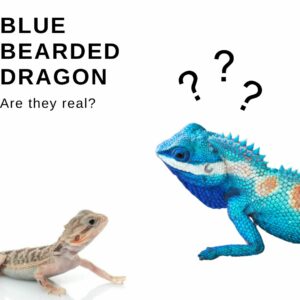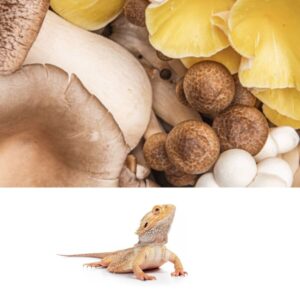No bearded dragon ages the same. Add genetics, and living conditions into the mix and you get to the point where you have to ask yourself “How old is my bearded dragon?
Due to their popularity, we cant always the breeders. We also often see abandoned beardies in shelters.
To help you determine the age of your bearded dragon, we will include charts, factors, and life stages.
let’s get to it.
How old is my bearded dragon by size: Bearded Dragon Age Chart
| Age (months) | Size (inches) | Weight (grams) |
| 1 | 3-4 | 4-6 |
| 2 | 5-9 | 8-40 |
| 3 | 8-11 | 22-110 |
| 4 | 9-12 | 41-115 |
| 5 | 11-16 | 102-115 |
| 6 | 11-18 | 183-188 |
| 7 | 13-18 | 230-280 |
| 8 | 14-20 | 252-327 |
| 9-10 | 16-22 | 280-360 |
| 11-12 | 16-24 | 350-465 |
| 12+ | 16+ | 380-465 |
| Bearded Dragon Subspecies | Size (inches) | Weight (grams) |
| Pogona microlepidota | 4 – 6 | 6-40 |
| Pogona henrylawsoni | 9-12 | 50 – 200 |
| Pogona minor mina | 10-12 | 100-200 |
| Pogona nullarbor | 12-14 | 200-250 |
| Pogona minor | 14-18 | 250-450 |
| Pogona minor mitchelli | 16-18 | 380-450 |
| Pogona vitticeps | 16-24 | 380-510 |
| Pogona barbata | 20-24 | 400-510 |
Table of Contents
How to tell how old a bearded dragon is
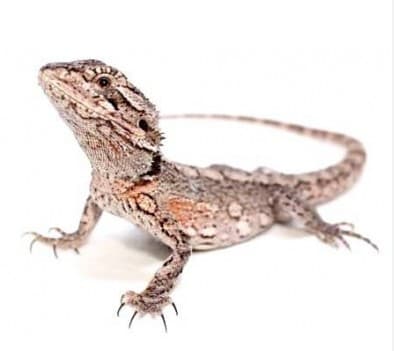
Determining a bearded dragon’s age can be challenging, particularly if you don’t know their birth date. However, there are a few methods you can use to estimate their age:
1. Size and Weight
Bearded dragons grow at different rates depending on their genetics, diet, and environmental conditions.
By measuring their length and weight, you can estimate their age. Typically, a bearded dragon will grow around 1 inch (2.5 cm) per month until they reach around 18 months of age. After that, their growth rate will slow down.
2. Physical Characteristics
The physical characteristics of a bearded dragon can give you an idea of their age.
For example, younger bearded dragons will have smoother skin, brighter colors, and smaller spikes on their back compared to older bearded dragons, who will have rougher skin, duller colors, and larger spikes.
3. Behavior and Activity Level
Younger bearded dragons tend to be more active and curious compared to older bearded dragons, who may be more lethargic and prefer to spend more time basking.
4. Teeth and gum condition
Like most reptiles, bearded dragons grow new teeth throughout their lives.
Younger bearded dragons will have smaller, sharper teeth, while older bearded dragons will have larger, more worn teeth.
It’s important to note that these methods are not always accurate and can only provide estimates. If you’re unsure about your bearded dragon’s age or have concerns about their health, consult with a veterinarian who specializes in reptiles for advice.
5. Skeletal maturity
Skeletal maturity refers to the point in a bearded dragon’s life when their bones have fully developed and fused together. This usually occurs when a bearded dragon reaches between 12-18 months of age, although the exact timing can vary depending on factors such as genetics, nutrition, and environmental conditions.
Skeletal maturity can affect their overall health and well-being. For example, if a bearded dragon is not allowed to fully develop their bones before being subjected to stress or heavy handling, it could increase their risk of bone fractures and other injuries.
Providing a calcium-rich diet, adequate UVB lighting, appropriate temperature, humidity levels, and regular veterinary checkups can also help ensure that your bearded dragon is growing and developing as it should.
6. Hatchling size and weight
On average, a bearded dragon hatchling can measure around 4-5 inches (10-13 cm) in total length, including the tail, and can weigh around 0.2-0.3 ounces (5-8 grams). However, hatchlings may be larger or smaller than this average range.
During the first few weeks of life, hatchlings are particularly vulnerable and require careful attention to their diet, temperature, and humidity levels to ensure proper growth and development.
If you’re raising bearded dragon hatchlings, it’s a good idea to consult with a veterinarian who specializes in reptiles to ensure that you’re providing the best possible care and support for your young dragons.
7. Growth rates
Growth rates can vary depending on whether a bearded dragon is male or female, with males typically growing larger than females, as well genetics, health, living conditions, etc.
General growth rates:
Hatchling to 3 months: During the first few months of life, bearded dragons can grow quite rapidly, adding around 0.2-0.4 inches (0.5-1 cm) per week. They can gain around 0.1-0.2 ounces (3-6 grams) in weight per week.
3 months to 6 months: Growth rates usually slow down a bit during this stage, with bearded dragons adding around 0.1-0.2 inches (0.3-0.5 cm) per week in length. They can gain around 0.1-0.3 ounces (3-9 grams) in weight per week.
6 months to 12 months: Bearded dragons continue to grow at a slower rate during this stage, adding around 0.1 inches (0.25 cm) per week in length. They can gain around 0.1-0.2 ounces (3-6 grams) in weight per week.
12 months and older: Once bearded dragons reach maturity at around 12-18 months of age, their growth rate will slow down significantly, adding only a few millimeters or so per year. However, they will continue to gain weight and develop in other ways, such as developing more vibrant colors and larger spikes on their back.
The difficulty of determining a bearded dragon’s age
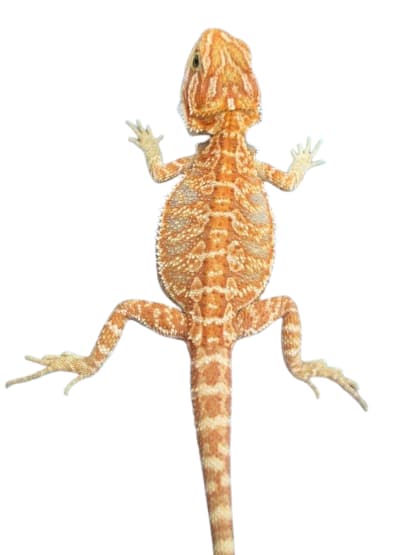
Determining the age of a bearded dragon can be difficult, especially if you acquired your dragon as an adult or if it was a wild caught.
There are some methods for estimating a bearded dragon’s age, but it can be challenging to determine their precise age.
Here are some methods to determine a bearded dragon’s age:
Size: A larger dragon is not necessarily older than a smaller dragon, and vice versa. Instead, it’s best to use size as one piece of information in conjunction with other factors, such as growth rate, shedding frequency, and tooth wear, to get a more accurate estimate of the animal’s age.
Growth rates: Healthy bearded dragons should grow steadily and consistently throughout their first year of life. During this time, the dragon should double or even triple in size, depending on its genetics and diet. After the first year, growth will slow down and the dragon will begin to reach its adult size.
Shedding frequency: Bearded dragons shed every few weeks to every few months, depending on their age and growth rate. Younger dragons may shed every two to four weeks, while older dragons may shed every three to six months. Shedding can also be affected by environmental factors such as temperature and humidity, as well as by the dragon’s diet and overall health.
Tooth wear: Bearded dragons continuously replace their teeth throughout their lives. As they age, their teeth will become worn down from use and may even begin to fall out.
In young bearded dragons, the teeth will be sharp and pointed with little to no wear. As the dragon ages, the teeth will become blunter and may show signs of grooves or indentations.
In very old dragons, the teeth may be worn down to the gums or even missing altogether.
Skeletal maturity: One way to assess skeletal maturity is to examine the dragon’s skull. In young bearded dragons, the skull will be small and undeveloped, with distinct sutures between the different bones. As the dragon ages, the skull will become larger and the sutures will become less distinct. The bones of the skull will also become thicker and more fused together.
Another way to assess skeletal maturity is to examine the dragon’s tail. In young bearded dragons, the tail will be thin and pliable, with distinct vertebrae that can be felt easily. As the dragon ages, the tail will become thicker and more rigid, and the individual vertebrae will become more difficult to feel.
Factors That Affect Bearded Dragon Growth
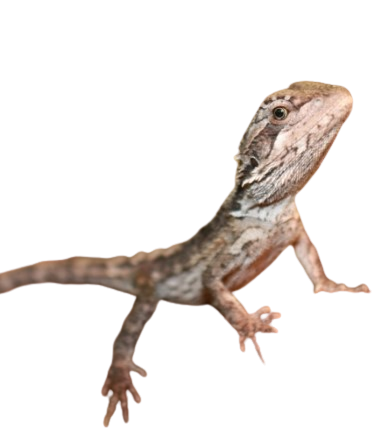
Bearded dragon genetics
Bearded dragons have a set of genes that determine their physical characteristics, including size and growth rate. These genes are inherited from their parents, and specific traits can be passed down from generation to generation.
For example, if a bearded dragon’s parents are large, there’s a good chance that the offspring will also grow to be large, if parents are small, the offspring will likely be small as well. However, genetics is not the only factor that affects bearded dragon growth.
Bearded dragon diet
Diet is another critical factor that affects growth. A balanced diet that includes a variety of protein sources, leafy greens, and vegetables is essential for healthy growth and development. A diet that is deficient in nutrients can lead to stunted growth, metabolic bone disease, and other health issues.
A diet that is deficient in nutrients can lead to stunted growth, metabolic bone disease, and other health issues.
A balanced diet should include a variety of protein sources, such as crickets, roaches, and mealworms, as well as leafy greens and vegetables.
Bearded environmental factors
Bearded dragons require specific environmental conditions to thrive. Temperature, humidity, and lighting play important roles in their growth and development.
Temperature:
Basking spot: 100-110°F (37.8-43.3°C)
Ambient temperature: 80-85°F (26.7-29.4°C)
Cool end: 75-80°F (23.9-26.7°C)
The temperature gradient in the enclosure so that the bearded dragon can regulate its body temperature by moving to different areas of the enclosure. The basking spot should be the warmest part of the enclosure, and the cool end should be the coolest.
Humidity levels should be maintained, and proper lighting is essential for their overall health. An inadequate environment can lead to health problems and slow growth.
Juvenile bearded dragons: 40-50%
Adult bearded dragons: 35-45%
High humidity can lead to respiratory infections and other health problems. A hygrometer can be used to monitor humidity levels in the enclosure.
Temperature and humidity requirements can vary depending on the geographic location and subspecies of the bearded dragon. It’s recommended to do research on the specific needs of your bearded dragon and adjust the temperature and humidity levels accordingly.
Bearded dragon age
Younger dragons will grow at a faster rate compared to older dragons, and their growth rate will start to slow down as they reach adulthood. It’s important to monitor their growth and adjust their care and diet accordingly as they age.
How old can a bearded dragon get
Bearded dragons have an average lifespan of around 10-15 years in captivity, although some individuals can live longer with proper care and attention. Factors such as genetics, diet, and environment can all impact the lifespan of a bearded dragon.
Adequate care is essential for maximizing a bearded dragon’s lifespan. This includes providing a healthy diet that is rich in calcium and other essential nutrients, maintaining appropriate temperature and humidity levels, and providing access to UVB lighting.
Bearded dragons may be more susceptible to certain health issues as they age, such as metabolic bone disease, kidney disease, and tumors.
Bearded dragon old age – Senior bearded dragon
The term “senior” can be used to describe bearded dragons that are in the later stages of their life, typically around 7-8 years of age or older.
However, the exact age at which a bearded dragon becomes a senior can vary depending on various factors, such as genetics, diet, and environment, and senior reptile care in general.
Senior bearded dragons may become more susceptible to certain health issues and changes in their behavior.
You can recognize older bearded dragons by:
Decreased activity: Older bearded dragons may be less active than younger individuals and may spend more time basking and resting.
Reduced appetite: Some older bearded dragons may have a reduced appetite, which can be a sign of underlying health issues. It’s important to monitor their food intake and consult with a veterinarian if you notice any significant changes.
Vision and hearing loss: Like other animals, bearded dragons may experience a decline in their vision and hearing as they age.
Mobility issues: Older bearded dragons may have difficulty moving around, climbing, or gripping surfaces, which can be a sign of arthritis or other age-related issues.
Increased risk of health issues: As bearded dragons age, they may be more susceptible to certain health issues, such as metabolic bone disease, kidney disease, and tumors.
Tips on keeping your bearded dragon happy and healthy
Best diet: Bearded dragons require a diet that is high in protein and low in fat. Offer them a variety of insects, such as crickets, mealworms, and roaches, as well as dark leafy greens, vegetables, and fruit. Avoid feeding your bearded dragon foods that are high in oxalates, such as spinach, as these can contribute to the development of metabolic bone disease.
Maintain temperatures: Bearded dragons require a basking spot with a temperature of around 100-110°F, as well as a cooler area with a temperature of around 80-85°F.
Lighting: Bearded dragons require exposure to UVB light to metabolize calcium and prevent metabolic bone disease. Make sure your bearded dragon has access to a full-spectrum UVB light for 10-12 hours a day.
Keep their enclosure clean: Regularly clean your bearded dragon’s enclosure to prevent the buildup of harmful bacteria and parasites. Remove any uneaten food, feces, and shed skin, and replace substrate as needed.
Provide enrichment: Bearded dragons are active and curious animals that require mental stimulation. Offer them climbing structures, hiding places, and toys to keep them engaged and prevent boredom.
Monitor their health: Regularly monitor your bearded dragon’s health and look out for signs of illness or injury, such as lack of appetite, lethargy, or abnormal behavior. Take them to the vet for regular checkups and address any health issues promptly.
Signs of a bearded dragon dying of old age
It can be difficult to watch a beloved pet become ill or pass away, but there are some signs that a bearded dragon may be approaching the end of their life due to old age. These can include:
Lack of appetite: A bearded dragon that is nearing the end of their life may lose their appetite and stop eating.
Lethargy: Bearded dragons that are close to passing away may become increasingly lethargic, spending most of their time sleeping or lying still.
Difficulty breathing: Older bearded dragons may have difficulty breathing, and you may notice labored breathing, wheezing, or coughing.
Weight loss: Bearded dragons that are nearing the end of their life may experience significant weight loss.
Disorientation: Older bearded dragons may become disoriented, confused, or unresponsive.
Organ failure: Bearded dragons that are dying of old age may experience organ failure, which can cause symptoms such as vomiting, diarrhea, or abnormal urination.
Knowing your bearded dragon’s age – takeaways
To know how to provide the best possible life for your bearded dragon you need to know its age, as each stage of life requires different structures.
Here are a few of them:
Care: Bearded dragons have specific care requirements that can vary depending on their age. For example, hatchlings and juvenile bearded dragons require more frequent feedings and higher temperatures than adult bearded dragons. Knowing your bearded dragon’s age can help you provide them with the appropriate care they need to thrive.
Health concerns: Certain health issues, such as metabolic bone disease, are more common in younger bearded dragons, while other conditions, such as renal failure, are more common in older individuals. Knowing your bearded dragon’s age can help you monitor their health and look out for signs of these and other conditions.
Stress in bearded dragons can cause a bunch of health issues and the first sign of it are bearded dragon stress marks.
Breeding: If you plan on breeding your bearded dragon, knowing their age can be important for determining when they are sexually mature and ready to breed.
Lifespan: Bearded dragons have a relatively long lifespan compared to other reptiles, with some individuals living up to 20 years or more. Knowing your bearded dragon’s age can give you an idea of how much time you can expect to spend with them and help you plan for their long-term care needs.
Herpetologists and vets should be involved in your bearded dragon’s health.
My Senior Paws is a participant in the Amazon Services LLC Associates Program, an affiliate advertising program designed to provide a means for sites to earn advertising fees by advertising and linking to Amazon.com. We also participate in other affiliate programs which compensate us for referring traffic.
